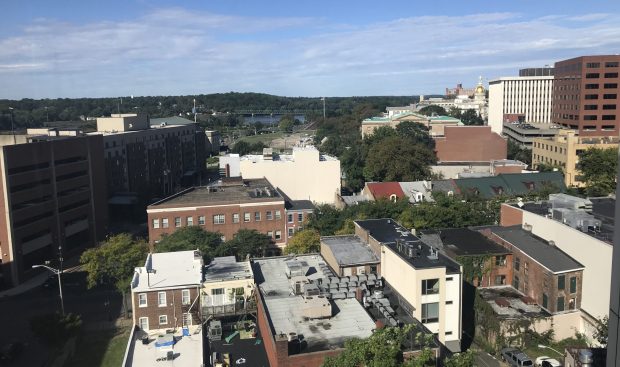New Jersey Future Blog
New Jersey Needs More “Missing Middle” Housing
July 19th, 2021 by Tim Evans

Aerial photo of Trenton, NJ.
- New Jersey’s housing costs are among the highest in the country. The state ranks seventh in median home value and fourth in median rent.
- The state is losing younger households to other states, and evidence points to high housing costs as one of the reasons.
- To create more of the kinds of homes that younger households are looking for—in the neighborhoods they want to live in—New Jersey should consider revising the zoning and parking requirements that determine what kind of housing gets built and where.
A recent Rutgers-Eagleton Poll, in collaboration with the Housing and Community Development Network of New Jersey, found that 90% of New Jerseyans are worried about the cost of housing in the state, with 55% considering it a “very serious” problem and another 35% saying it is “somewhat serious.” And 80% feel the same way about finding an affordable place to rent (49% “very serious” and 32% “somewhat serious”).
They are not wrong to worry—New Jersey is an expensive state. As of the 2019 one-year American Community Survey1, New Jersey’s median gross rent of $1,376 is the fourth-highest in the nation after Hawaii, California, and Maryland. And on median home value (self-reported), it ranks seventh after Hawaii, California, Massachusetts, Colorado, Washington, and Oregon.
To a certain extent, this is a function of New Jersey’s status as a high-income state—our median household income of $85,751 is the third-highest in the country after Maryland and Massachusetts. It is broadly true that the states with the highest housing costs also tend to have the highest incomes (Hawaii, California, Washington, and Colorado all also appear in the top 10 for household income). Typically, the higher a household’s income, the more it is able to spend on housing.
Living with Parents
For younger New Jerseyans on the lower end of the income ladder, however, high home prices and rents can present a significant barrier to forming their own households and staying in New Jersey when they do move out on their own. New Jersey has the highest incidence among the 50 states of people ages 18 to 34 living with their parents (45.4%, or nearly half). Only Connecticut (41.7%) and Rhode Island (41.1%) also exceed 40%, with notoriously expensive California just behind at 39.5%. (The national rate is 34.0%.) When faced with an expensive housing market, many younger New Jerseyans choose to delay getting their own place.
Paying More Than You Can Afford
An extended post-graduation stay with parents is one way to save on rent or to save up to buy a house. But not everyone finds this option feasible or desirable. Some will just bite the bullet and spend more on housing than they can realistically afford. Indeed, New Jersey has the fourth-highest rate among the 50 states of households paying more than 30% of their gross income on housing costs (such households are considered “housing-cost burdened”), behind only California, Hawaii, and New York. The percentage is unsurprisingly higher among renters than homeowners, as is true elsewhere—nationally, 48.4% of renter households are cost-burdened, compared to only 21.3% of homeowner households. But New Jersey actually only ranks 12th-highest when looking exclusively at the rate of housing cost burden among renters—its rate of 49.0% is only slightly higher than the national rate.
Where New Jersey stands out is in its cost-burdened rate among households that own their homes, which, at 28.9%, is the third-highest rate in the country behind Hawaii and California. This is likely due—in part—to New Jersey’s notoriously high property taxes. New Jersey’s median real estate tax bill of $8,432 is the highest in the country by a wide margin and one-third higher than second-place Connecticut ($6,004). In New Jersey, homeownership is not necessarily a reliable hedge against rising housing costs, because of the potential to face rising property tax bills.
Moving Out of State
Given New Jersey’s high housing costs, some younger people seeking to form their own households simply choose to leave the state entirely. In 2017, New Jersey Future found that 22-to-34-year-olds (an age range then consisting entirely of members of the Millennial generation) were moving to compact, walkable towns (consistent with the national media narrative at the time), but that Millennials also appeared to be leaving the state in large numbers. A subsequent 2018 analysis confirmed that Millennials were indeed underrepresented in New Jersey’s population, compared to their share of the population nationwide, raising the question of where New Jersey’s “missing Millennials” had gone. Further research into the destinations of New Jersey’s out-migrating Millennials suggested that many of them were relocating to other parts of the country where they could find the walkable, mixed-use neighborhoods they were looking for, but where they could actually afford to buy or rent a home.
Constraints on Supply and Induced Demand
What can New Jersey do to bring down the costs of housing so that young people can afford to live near where they grew up if they so desire? A seemingly obvious solution is to increase the supply of the kinds of housing younger households are looking for, in the kinds of places where they want to live. But this is easier said than done; housing markets are constrained both by a finite supply of land and by government regulation in the form of local zoning. Additionally, many markets in New Jersey have such high demand that increasing supply will not realistically reduce housing prices, and in some cases will actually induce further demand. Would-be suppliers (i.e., residential developers) may have a sense of what kind of housing the market wants, but they may not be able to build it fast enough or build it in the right places, because local zoning prevents them from doing so. And when they are able to build it, induced demand can simply push prices higher.
Building new homes in the right places is an important part of the solution. Today’s young adults don’t want the suburban tract home at the end of the cul-de-sac that characterized their parents’ generation. They want walkable neighborhoods and traditional downtowns where they don’t need to drive 3 miles every time they leave the house. And they want other housing options besides a single-family detached home on a big lot, like townhouses, duplexes, small apartment buildings, apartments above stores, and smaller single-family homes–options that were once common but are now sometimes referred to as the “missing middle” between single-family detached homes and large apartment complexes. Even older Millennials who may have lived in the “city” when they were younger but are now looking for a bit more space are not moving to the same kinds of “suburbs” as previous generations and are instead gravitating toward smaller centers.
Removing Barriers and Building in Affordability
The good news is that New Jersey already contains many smaller cities, walkable suburban downtowns, and transit-adjacent neighborhoods that offer the live-work-shop-play balance that many younger households (and aspiring future households) are seeking. Oftentimes these places do not contain an adequate supply of smaller units that are relatively more affordable than their larger counterparts. The question is how to start producing more housing in these places of the sizes and types that prospective buyers and renters want. This generally means removing barriers to the production of these housing types so that suppliers are free to try to catch up with demand while simultaneously looking to build in more permanent affordability for lower income residents. Steps New Jersey can pursue (and which some other states, counties, and cities are already pursuing) include:
- Accessory dwelling units: Allow the creation of accessory dwelling units (ADUs) (e.g., in-law suites, above-garage apartments, etc.) on single-family lots as-of-right. Los Angeles County offers an example, having recently modified its ordinances to make the creation of ADUs much easier. AARP has developed a model ordinance for state and local governments that are interested in pursuing this option. ADUs would also help older residents remain in their communities as they age.
- Zoning reform: Increase the production of “missing middle” housing types by curtailing municipalities’ ability to zone for nothing but single-family detached housing. Removing restrictions on other housing types would free up markets to expand housing options. The city of Minneapolis abolished single-family zoning citywide in 2018, and other cities are considering similar moves; the website Strong Towns provides a good recent review of where this movement is enjoying some success, including a few cities in California. Oregon even took the bold state-level step of passing a law in 2019 that requires all cities with populations of at least 25,000 to allow two-, three-, and four-unit structures, as well as townhouses, in any neighborhood previously zoned only for single-family detached homes. Oregon thus offers a model for state-level action that does not wait for individual cities and towns to loosen zoning on their own.
- Reduce or eliminate parking minimums: One way to make room for more housing is to devote more space to homes and less to car storage. Parking takes up space—and costs money—that could otherwise be devoted to producing more housing units. Reducing parking requirements would likely reduce builders’ construction costs per unit, pulling prices downward. In 2017, Buffalo became the first city to eliminate minimum parking requirements for all new development citywide, which has led to more shared parking and fewer new parking spaces in the densest parts of the city and has allowed some new projects to proceed that might not have been financially viable under the old requirements. The smaller city of Fayetteville, Arkansas actually beat Buffalo to the punch by two years, although it eliminated parking requirements only for commercial development. A bill is working its way through the California legislature that would eliminate parking minimums for new projects located in neighborhoods served by transit. Berkeley has not waited for the state, doing away with parking minimums in almost all residential neighborhoods citywide. Existing surface parking lots also serve as a sort of urban land bank for built-out areas, offering opportunities for infill development and higher-density housing. In New Jersey, Metuchen built the Woodmont Metro at Metuchen Station project on a former commuter surface parking lot, creating new housing options in a town that had been dominated by single-family detached homes and improving its downtown walkability in the process.
- Regionalizing school districts: New Jersey’s public-school landscape is particularly fragmented. It averages 28 school districts per county,2 the most of any state, and averages just under 15,000 residents per school district, well below the national average of 23,344. Such fragmentation results in duplicative costs for administration, buildings, and equipment and drives up the property taxes that fund public education, which in turn drives up overall housing costs. Moving toward more regional school districts would create economies of scale and would likely help bring costs and property taxes down. Increasing the geographic size of school districts would also mitigate competition for taxable property among districts and reduce local government resistance to residential development, clearing the path for developers to build more housing to meet demand.
- Long-term affordability mechanisms: As neighborhoods become more desirable, prices will rise. To help ensure that our most desirable and opportunity-laden communities are available to people of all incomes and races, it is important for towns to proactively remove a percentage of housing from the investor marketplace and keep rents and sale prices affordable for the long-term. This can be accomplished through a number of mechanisms including inclusionary housing development with proper affordability targeting and controls; buying down market rate houses and apartment units and putting in place long-term deed restrictions; and developing long-term ownership structures like nonprofit owned housing complexes and community land trusts.
1This and all subsequent housing and income statistics are from the 2019 one-year American Community Survey unless otherwise indicated.
2Using data from the 2017 Census of Governments
Related Posts
Tags: missing middle
















